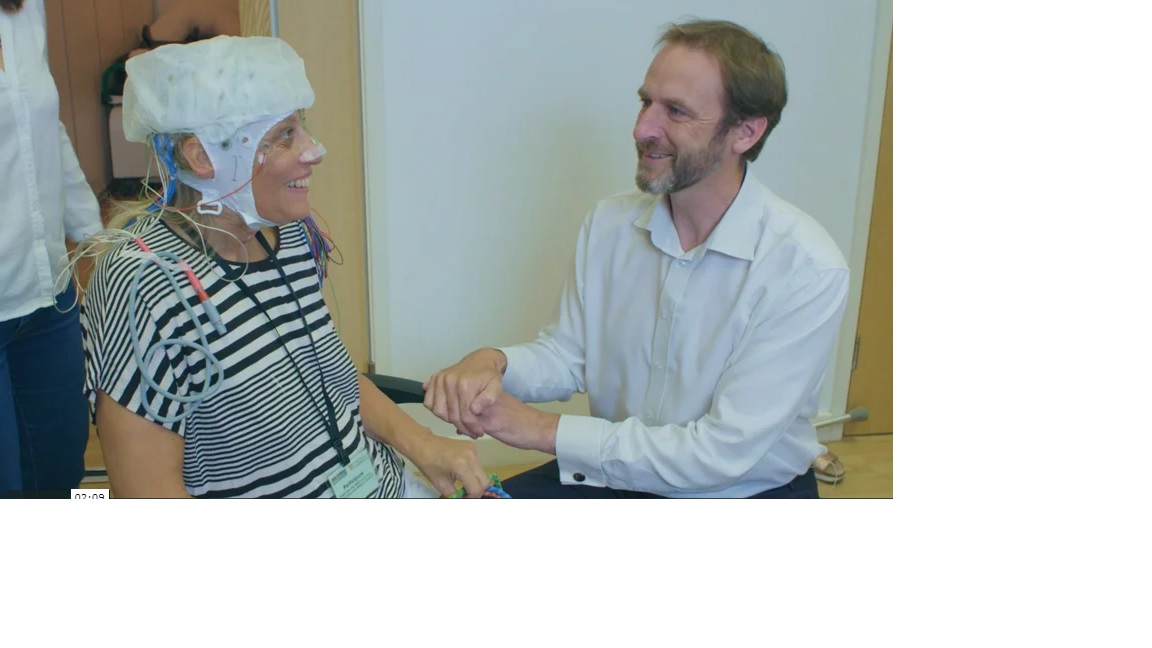
Successful Cognitive Ageing in Healthy Adults
Understanding the underlying mechanisms of ageing and related changes in cognition and neural architecture in healthy individuals is crucial for the investigation of ageing in patients with dementia.
The Cambridge Centre for Ageing and Neuroscience (Cam-CAN) is a large-scale collaborative research project, launched in October 2010 by Professor Lorraine K. Tyler, with substantial funding from the Biotechnology and Biological Sciences Research Council (BBSRC). The Cam-CAN project is using epidemiological, behavioural, and neuroimaging data to understand how individuals can best retain cognitive abilities into old age.
Several researchers in our group use the Cam-CAN data set in order to investigate network dynamics of the ageing brain, decision-making, and action control.
Voluntary Action and Decision Making
Another important part of our group's research is on understanding the neuroscientific basis of behavioural control and voluntary action selection either in healthy individuals or clinical populations. This is important as many patients with Frontotemporal dementia show affected volition such as apathy and impulsivity. We develop novel paradigms and questionnaires, use computational neuroscience approaches, and neural network analyses in order to understand the underlying mechanisms.
Researchers
- Professor James B. Rowe
- Professor Lorraine K. Tyler (Department of Psychology)
- Dr Alessandro Tomassini (MRC CBSU)
- Dr Kamen Tsvetanov (Department of Psychology)
- Frank Hezemans (MRC CBSU)
- Gunther Klobe
Selected Publications
- Samu, D., Campbell, K. L., Tsvetanov, K. A., Shafto, M. A., Cam, C. A. N. c., & Tyler, L. K. (2017). Preserved cognitive functions with age are determined by domain-dependent shifts in network responsivity. Nat Commun, 8, 14743. doi:10.1038/ncomms14743 PMID: 28480894 PMC5424147
- Price, D., Tyler, L. K., Neto Henriques, R., Campbell, K. L., Williams, N., Treder, M. S., Taylor, J. R., Cam, C. A. N., & Henson, R. N. A. (2017). Age-related delay in visual and auditory evoked responses is mediated by white- and grey-matter differences. Nat Commun, 8, 15671. doi:10.1038/ncomms15671 PMID: 28598417 PMC5472747
- Henson, R. N., Campbell, K. L., Davis, S. W., Taylor, J. R., Emery, T., Erzinclioglu, S., Cam, C. A. N., & Kievit, R. A. (2016). Multiple determinants of lifespan memory differences. Sci Rep, 6, 32527. doi:10.1038/srep32527 PMID: 27600595 PMC5013267
- Phillips, H. N., Blenkmann, A., Hughes, L. E., Kochen, S., Bekinschtein, T. A., Cam, C., & Rowe, J. B. (2016). Convergent evidence for hierarchical prediction networks from human electrocorticography and magnetoencephalography. Cortex, 82, 192-205. doi:10.1016/j.cortex.2016.05.001 PMID: 27389803 PMC4981429
- Wolpe, N., Ingram, J. N., Tsvetanov, K. A., Geerligs, L., Kievit, R. A., Henson, R. N., Wolpert, D. M., Cam, C. A. N., & Rowe, J. B. (2016). Ageing increases reliance on sensorimotor prediction through structural and functional differences in frontostriatal circuits. Nat Commun, 7, 13034. doi:10.1038/ncomms13034 PMID: 27694879 PMC5063954
- Zhang, J., Nombela, C., Wolpe, N., Barker, R. A., & Rowe, J. B. (2016). Time on timing: Dissociating premature responding from interval sensitivity in Parkinson's disease. Mov Disord, 31(8), 1163-1172. doi:10.1002/mds.26631 PMID: 27091513 PMC4988382
- Rae, C. L., Hughes, L. E., Weaver, C., Anderson, M. C., & Rowe, J. B. (2014). Selection and stopping in voluntary action: a meta-analysis and combined fMRI study. Neuroimage, 86, 381-391. doi:10.1016/j.neuroimage.2013.10.012 PMID: 24128740 PMC3898966
- Wolpe, N., Wolpert, D. M., & Rowe, J. B. (2014). Seeing what you want to see: priors for one's own actions represent exaggerated expectations of success. Front Behav Neurosci, 8, 232. doi:10.3389/fnbeh.2014.00232 PMID: 25018710 PMC4073091
- Wolpe, N., Haggard, P., Siebner, H. R., & Rowe, J. B. (2013). Cue integration and the perception of action in intentional binding. Exp Brain Res, 229(3), 467-474. doi:10.1007/s00221-013-3419-2 PMID: 23371752 PMC3745826
- Zhang, J., Hughes, L. E., & Rowe, J. B. (2012). Selection and inhibition mechanisms for human voluntary action decisions. Neuroimage, 63(1), 392-402. doi:10.1016/j.neuroimage.2012.06.058 PMID: 22776456 PMC3445813
- Rowe, J. B., Hughes, L., & Nimmo-Smith, I. (2010). Action selection: a race model for selected and non-selected actions distinguishes the contribution of premotor and prefrontal areas. Neuroimage, 51(2), 888-896. doi:10.1016/j.neuroimage.2010.02.045 PMID: 20188184 PMC2877799
- Rowe, J., Hughes, L., Eckstein, D., & Owen, A. M. (2008). Rule-selection and action-selection have a shared neuroanatomical basis in the human prefrontal and parietal cortex. Cereb Cortex, 18(10), 2275-2285. doi:10.1093/cercor/bhm249 PMID: 18234684 PMC2536699

